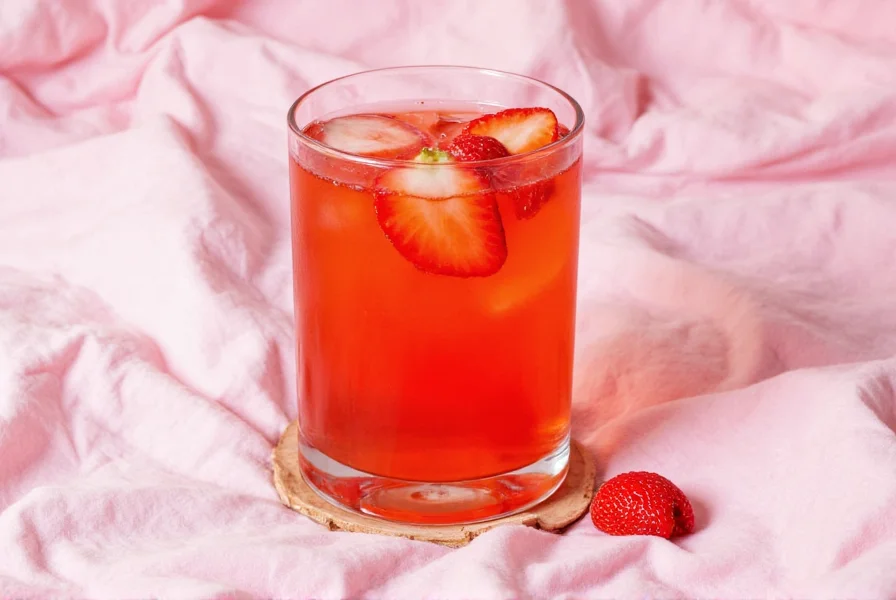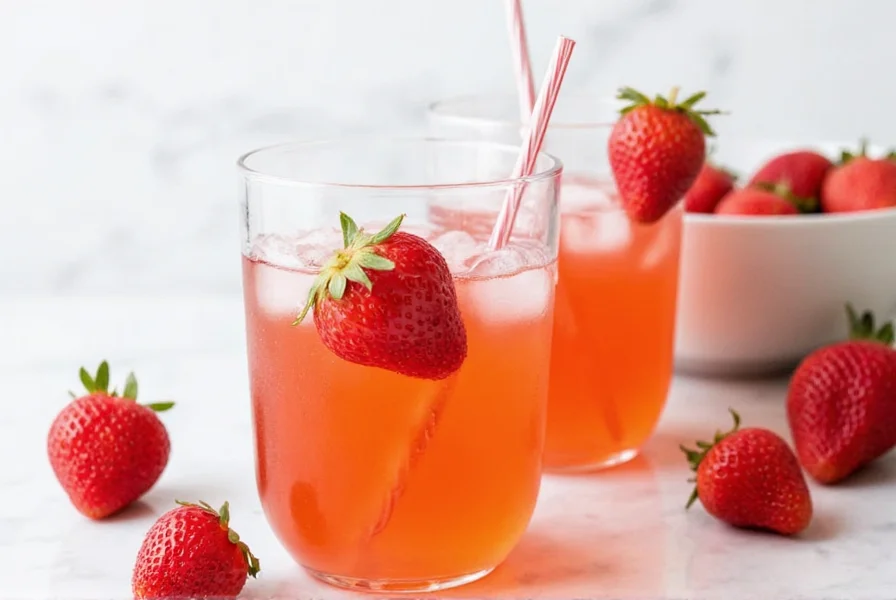When searching for information about strawberry ginger ale, you're likely looking for more than just a basic definition. This comprehensive guide explores the nuances of this popular beverage, including its flavor profile, variations, and how it differs from similar drinks. Whether you're a home mixologist seeking the perfect recipe or simply curious about this refreshing drink, you'll find valuable insights here.
What Exactly Is Strawberry Ginger Ale?
Strawberry ginger ale represents a modern twist on traditional ginger ale, incorporating fresh strawberry elements to create a balanced beverage with both spicy and sweet characteristics. Unlike ginger beer, which undergoes fermentation and has a stronger ginger kick, strawberry ginger ale maintains the lighter profile of standard ginger ale while adding fruit complexity.
The key distinction lies in the ginger preparation method. Traditional ginger ale uses ginger extract or syrup with minimal fermentation, resulting in lower carbonation and a milder ginger flavor compared to ginger beer's robust, fermented profile. When strawberries enter the equation, they complement rather than overpower the ginger's distinctive warmth.

Flavor Profile and Characteristics
Understanding the flavor balance in strawberry ginger ale helps appreciate why it has gained popularity among beverage enthusiasts. The ideal version achieves harmony between several elements:
| Component | Contribution | Ideal Proportion |
|---|---|---|
| Ginger | Spicy warmth, slight heat | Moderate (noticeable but not overwhelming) |
| Strawberry | Sweet fruitiness, subtle tartness | Prominent but balanced |
| Carbonation | Refreshing mouthfeel | Light to medium |
| Sweetness | Counteracts ginger heat | Controlled (not syrupy) |
This balance makes strawberry ginger ale particularly versatile. It works beautifully as a standalone non-alcoholic beverage, especially when served chilled over ice with a fresh strawberry garnish. Mixologists also prize it as a sophisticated cocktail mixer that adds complexity without overwhelming other ingredients.
Homemade vs. Commercial Strawberry Ginger Ale
While several brands now offer strawberry ginger ale commercially, the homemade version provides distinct advantages for those willing to invest minimal effort. Commercial products often contain preservatives, artificial flavors, and higher sugar content to ensure shelf stability.
A quality homemade strawberry ginger ale recipe typically requires just five core ingredients:
- Fresh ginger root (peeled and sliced)
- Ripe strawberries (hulled and chopped)
- Water (filtered preferred)
- Sugar or alternative sweetener
- Carbonation source (seltzer water or carbonation system)

Creating Perfect Homemade Strawberry Ginger Ale
For those interested in the best strawberry ginger ale from scratch, follow this reliable method that yields consistently excellent results:
- Prepare the ginger syrup: Simmer 1 cup sliced ginger in 2 cups water for 15 minutes. Add 1½ cups sugar and simmer 5 more minutes. Strain and cool.
- Make strawberry infusion: Blend 1½ cups fresh strawberries with ½ cup of the cooled ginger syrup until smooth. Strain through fine mesh.
- Combine elements: Mix strawberry infusion with remaining ginger syrup.
- Carbonate: Chill mixture thoroughly, then add to carbonated water (3 parts carbonated water to 1 part syrup) or use a carbonation system.
- Chill and serve: Refrigerate for at least 2 hours before serving over ice with fresh strawberry garnish.
The secret to exceptional strawberry ginger ale lies in using peak-season strawberries and adjusting sweetness to taste. Remember that ginger's potency varies by root, so start with less and increase to your preferred spice level. For a sophisticated adult version, this base makes an excellent strawberry ginger ale cocktail mixer with vodka or bourbon.
Health Considerations of Strawberry Ginger Ale
When evaluating strawberry ginger ale health benefits, consider both components. Ginger contains gingerol, a bioactive compound with anti-inflammatory properties that may aid digestion and reduce nausea. Strawberries contribute vitamin C, manganese, and antioxidants.
However, be mindful of sugar content. Commercial versions often contain 20-30g of sugar per 12oz serving. The homemade strawberry ginger ale recipe allows you to control sweetness, potentially reducing sugar by 30-50% compared to store-bought options while maintaining great flavor.
For those monitoring sugar content in strawberry ginger ale, consider these modifications:
- Use half the recommended sugar and supplement with erythritol or monk fruit sweetener
- Increase ginger concentration to enhance perceived sweetness
- Add a touch of lemon juice to balance flavors with less sugar
- Use very ripe strawberries which provide natural sweetness
Serving Suggestions and Pairings
Strawberry ginger ale shines in various serving contexts. As a standalone beverage, serve it chilled in a highball glass with fresh strawberry slices and a sprig of mint. The best strawberries for ginger ale are fully ripe but firm varieties like Albion or Seascape, which provide optimal flavor without excessive water content.
This beverage pairs exceptionally well with:
- Light salads featuring spinach, goat cheese, and pecans
- Grilled chicken or fish with citrus marinades
- Asian-inspired dishes with mild spice levels
- As a palate cleanser between courses
For cocktail applications, the strawberry ginger ale cocktail mixer works beautifully in place of standard ginger ale in Moscow Mules or Dark and Stormies, adding fruit complexity while maintaining the ginger backbone.
Frequently Asked Questions
What's the difference between strawberry ginger ale and strawberry ginger beer?
Ginger beer undergoes fermentation, resulting in stronger ginger flavor, higher carbonation, and sometimes minimal alcohol content (typically under 0.5%). Strawberry ginger ale uses ginger extract without fermentation, yielding milder ginger flavor, lighter carbonation, and no alcohol. The strawberry element is incorporated similarly in both, but the base beverage characteristics differ significantly.
How long does homemade strawberry ginger ale last?
Properly stored in airtight bottles in the refrigerator, homemade strawberry ginger ale maintains best quality for 5-7 days. The fresh strawberry component begins deteriorating after this period, though the ginger syrup base (without strawberries) can last 2-3 weeks refrigerated. For optimal flavor and freshness, consume within 3 days of preparation.
Can I make strawberry ginger ale without added sugar?
Yes, though the flavor profile will differ significantly. Sugar balances ginger's heat and strawberry's potential tartness. For sugar-free versions, use very ripe strawberries for natural sweetness and consider adding a touch of stevia or monk fruit extract. Note that completely sugar-free versions may taste overly spicy and lack the traditional ginger ale mouthfeel. The ginger's natural pungency requires some sweet counterbalance for most palates.
Why does my homemade strawberry ginger ale lack carbonation?
Proper carbonation requires either using very cold carbonated water when mixing (adding it last to preserve bubbles) or using a carbonation system. If making from scratch with fermentation, ensure proper sugar levels for yeast activity and adequate sealing during carbonation phase. Commercial ginger ales achieve carbonation through forced carbonation under pressure, which is difficult to replicate at home without specialized equipment.
What are the best strawberries to use for strawberry ginger ale?
Firm, fully ripe strawberries with deep red color provide optimal flavor. Varieties like Albion, Seascape, or Chandler offer excellent balance of sweetness and tartness. Avoid overripe or watery berries, which dilute flavor. For best results, use strawberries at peak season (late spring to early summer in most climates) and process them immediately after washing to preserve flavor compounds.










 浙公网安备
33010002000092号
浙公网安备
33010002000092号 浙B2-20120091-4
浙B2-20120091-4